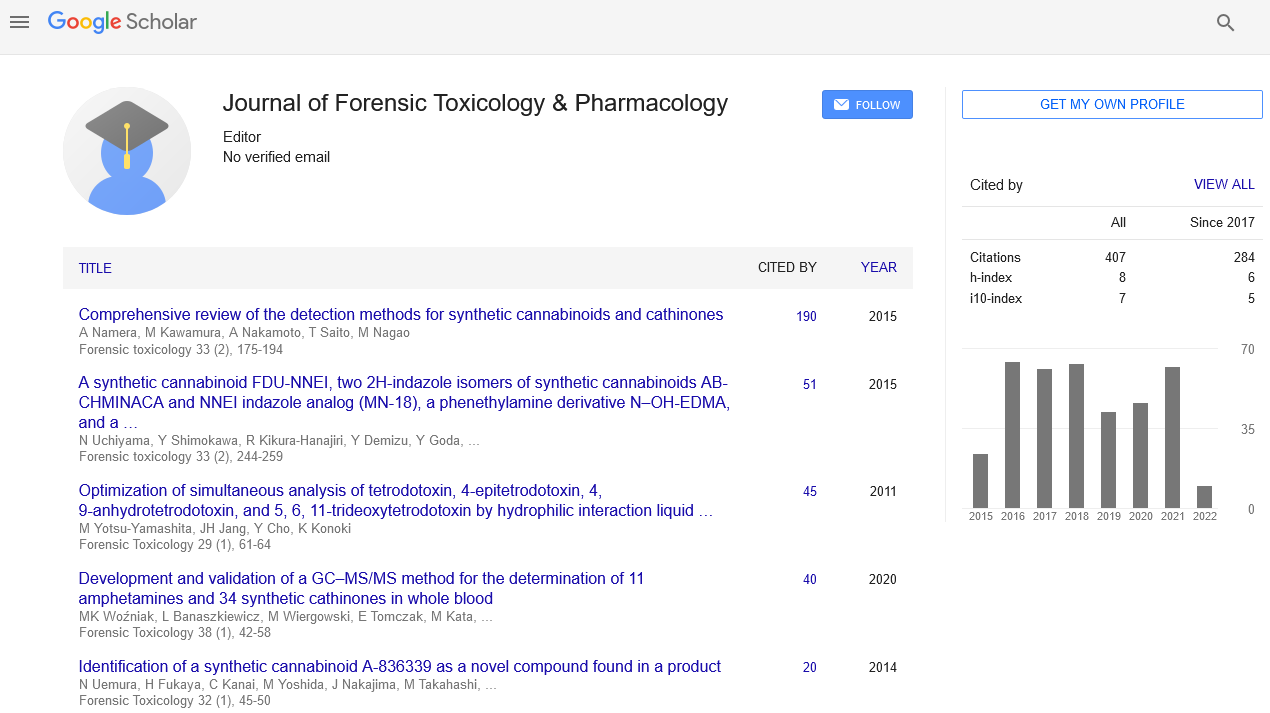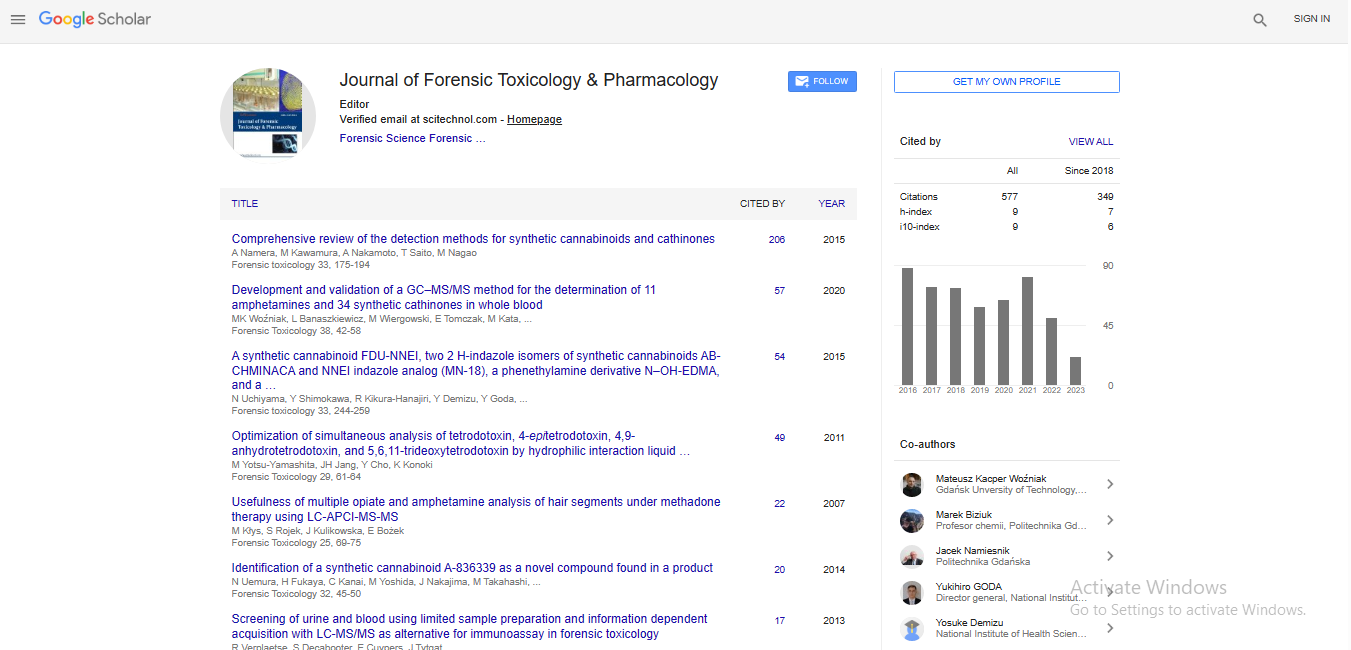Commentary, J Forensic Toxicol Pharmacol Vol: 13 Issue: 3
Polypharmacy and Drug-Drug Interactions: A Toxicological Perspective on Aging Populations
Sophie Dubois*
1Department of Pharmacology, University of Paris, Paris, France
*Corresponding Author: Sophie Dubois,
Department of Pharmacology, University
of Paris, Paris, France
E-mail: duboissophie@gmail.com
Received date: 26 August, 2024, Manuscript No. JFTP-24-151891;
Editor assigned date: 28 August, 2024, PreQC No. JFTP-24-151891 (PQ);
Reviewed date: 11 September, 2024, QC No JFTP-24-151891
Revised date: 18 September, 2024, Manuscript No. JFTP-24-151891 (R);
Published date: 25 September, 2024, DOI: 10.4172/JFTP.1000201
Citation: Dubois S (2024) Polypharmacy and Drug-Drug Interactions: A Toxicological Perspective on Aging Populations. J Forensic Toxicol Pharmacol 13:3.
Description
As people age, they often rely on a range of medications to manage chronic illnesses. This practice, known as polypharmacy, involves using multiple medications to address various health conditions and symptoms. Although medications are essential for treating diseases and improving quality of life, polypharmacy raises the risk of drugdrug interactions, which can have significant toxicological consequences in aging populations.
Polypharmacy has become increasingly common among older adults, driven by a higher prevalence of chronic conditions such as hypertension, diabetes, cardiovascular diseases and arthritis. Studies reveal that individuals over the age of 65 often take five or more medications daily. This pattern may enhance the therapeutic effects of each medication but simultaneously increases the likelihood of adverse interactions and side effects.
The challenge arises from the body’s changing capacity to process and respond to medications with age. Age-related physiological changes, like slower metabolism and decreased kidney and liver function, can impact how the body absorbs, distributes and eliminates drugs. As a result, the effectiveness and toxicity of certain medications can be altered, creating an elevated risk for adverse reactions when multiple medications interact.
Drug-drug interactions occur when the effects of one drug are modified by another. These interactions may increase or decrease the effectiveness of one or both medications or result in unexpected side effects. There are three primary types of drug-drug interactions.
These interactions involve the combined effects of drugs that act on the same biological pathways. For instance, two drugs that affect blood pressure can lead to excessively low blood pressure when used together, resulting in dizziness or fainting in older adults.
Pharmacokinetic interactions occur when one drug affects the absorption, distribution, metabolism, or excretion of another. This type is especially relevant in older adults, as many drugs are metabolized by the liver and eliminated through the kidneys. Drugs that affect liver enzymes can either accelerate or slow down the metabolism of other medications, leading to either reduced efficacy or heightened toxicity.
Additive effects occur when two drugs with similar effects produce a cumulative outcome, which can lead to unintended side effects. For example, combining sedatives and opioid pain relievers can amplify drowsiness or respiratory depression. Synergistic effects, where combined drugs create an effect greater than expected, can further complicate treatment for older adults and may cause life-threatening reactions.
The toxicological risks associated with polypharmacy are not solely due to the number of medications taken. Several factors contribute to this increased risk:
Older adults often experience multiple chronic conditions that require ongoing treatment. Managing these conditions with a wide range of medications can increase the risk of adverse effects and drug interactions, complicating patient care. Aging alters how the body processes medications, particularly in the liver and kidneys. These changes can affect the speed and efficiency of drug elimination, resulting in prolonged exposure to drugs or their active metabolites. Polypharmacy can lead to challenges in medication adherence, with older adults sometimes struggling to remember complex dosing schedules. Missed doses, accidental overuse, or abrupt discontinuation can all result in unanticipated reactions, particularly when drugs interact in unpredictable ways.
Reducing the toxicological risks associated with polypharmacy requires a careful, patient-centered approach. Medical professionals play a key role in monitoring and managing medications, routinely assessing patients’ medications and adjusting as needed. Strategies to minimize risks include.
Healthcare providers should review patients’ medications periodically, evaluating for potential interactions and considering if any medications are unnecessary. Adjustments or simplifications to medication regimens may reduce risks. Educating patients and caregivers on potential drug interactions, expected side effects and the importance of adherence is important in minimizing risks. Clear instructions can help older adults take medications correctly, avoiding common mistakes associated with polypharmacy.
Pharmacogenetics, which examines how individual genetic variations influence drug responses, may be useful in tailoring medications. This testing could identify individuals at higher risk for specific drug interactions, potentially guiding safer prescribing practices. Polypharmacy remains a necessary but complex aspect of healthcare for aging populations. The toxicological risks associated with drug-drug interactions confirm the need for vigilance in prescribing and managing multiple medications. Through regular reviews, clear patient education and possible pharmacogenetic insights, healthcare providers can support safer, more effective medication use, helping to improve the overall well-being of older adults while minimizing the risks inherent in polypharmacy.
 Spanish
Spanish  Chinese
Chinese  Russian
Russian  German
German  French
French  Japanese
Japanese  Portuguese
Portuguese  Hindi
Hindi 
